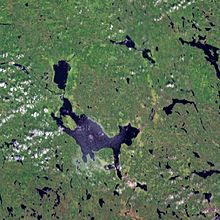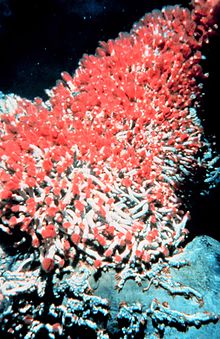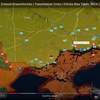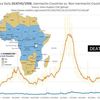Gold discovered that the location of major oil-producing regions in the Middle East and southeast Asia was defined by large scale patterns in surface geology and topography, such as deep fault lines. Leita á Íslandi, sjó og landi.
000
Fara aðeins neðar
Origins of petroleum[edit]
Setti á blog: Ómar Ragnarsson
"Asni klyfjaður gulli kemst yfir hvaða borgarmúr, sem er."
Jónas Gunnlaugsson, 16.7.2022 kl. 11:22
000
Fara niðurfyrir þessa og lesa
Origins of petroleum[edit]
000
Relationship with NASA[edit]

From the 1950s, Gold served as a consultant to NASA and held positions on several national space committees, including the President's Science Advisory Committee, as the United States tried to develop its space program. At the time, scientists were engaged in a heated debate over the physical properties of the moon's surface. In 1955, he predicted that the Moon was covered by a layer of fine rock powder stemming from "the ceaseless bombardment of its surface by Solar System debris".[24] This led to the dust being jokingly referred to as "Gold dust"[32] or "Gold's dust".[33] Gold initially suggested that astronauts would sink into the dust, but upon later analysis of impact craters and electrostatic fields, he determined that the astronauts' boots would sink only three centimeters into the Moon's surface. In any case, NASA sent unmanned Surveyors to analyze the conditions on the surface of the Moon. Gold was ridiculed by fellow scientists, not only for his hypothesis, but for the approach he took in communicating NASA's concerns to the American public; in particular, some experts were infuriated with his usage of the term "moon dust" in reference to lunar regolith.[34] When the Apollo 11 crew landed on the Moon in 1969 and brought back the first samples of lunar rocks, researchers found that lunar soil was in fact powdery. Gold said the findings were consistent with his hypothesis, noting that "in one area as they walked along, they sank in between five and eight inches". However, Gold received little credit for his correct prediction, and was even criticized for his original prediction of a deep layer of lunar dust.[24] Gold had also contributed to the Apollo program by designing the Apollo Lunar Surface Closeup Camera (ALSCC) (a kind of stereo camera) used on the Apollo 11, 12, and 14 missions.[24][35]
In the 1970s and 1980s, Gold was a vocal critic of NASA's Space Shuttle program, deriding claims that the agency could fly 50 missions a year or that it could have low budget costs. NASA officials warned Gold that if he testified his concerns before Congress, his research proposals would lose their support from NASA. Gold ignored the warning and testified before a Congressional committee headed by Senator Walter Mondale. In a letter to NASA administrator James C. Fletcher, George Low wrote that "Gold should realize that being funded by the Government and NASA is a privilege, and that it would make little sense for us to fund him as long as his views are what they are now".[36] Gold recalled the aftermath of his testimony in a 1983 interview with astronomy historian David H. DeVorkin:
I had a very hard time with NASA, year after year. I got some more money, but eventually it fizzled out, after three years or so after this event. My applications, which previously each year had always gone through very smoothly, were turned down. I would then have to go to Washington, discuss it with them. and I then would get a certain fraction of it resurrected. For several years running this happened, and then eventually it fizzled permanently, and I've not tried to get any money out of NASA since.
...
I was certainly regarded as persona non grata with NASA after that. I had a very hard time. Shortly after that Noel Hinners became the Space Science administrator, and he used to joke about it and say, "Oh. Tommy's got to come to his annual pilgrimage to Washington," and regarded it as very funny, but then he'd always give me some money. But always clearly as a persona non grata.[37]
Origins of petroleum[edit]
Gold first became interested in the origins of petroleum in the 1950s, postulating a theory on the abiogenic formation of fossil fuels. Gold engaged in thorough discussion on the matter with Fred Hoyle, who even included a chapter on "Gold's Pore Theory" in his 1955 book Frontiers in Astronomy.[26][38] In the late 1970s, just as the United States faced another major energy crisis, Gold resurrected his work on petroleum. In 1977, a research submarine near the Galapagos Islands discovered a number of thriving ecosystems down on the ocean floor, living alongside hydrothermal vents. Later expeditions found that these vents were host to a number of organisms, including giant tube worms and albino crabs, that survived off heat-loving chemosynthetic microbes. The discovery of life in this adverse environment led Gold to reconsider the established interpretation of biogenic petroleum formation. Gold believed that "biology is just a branch of thermodynamics" and that the history of life is just "a gradual systematic development toward more efficient ways of degrading energy".[39]
He began his investigation by studying how earthquakes facilitated the migration of methane gas from the deep Earth to the surface.[40] He speculated that a large enough earthquake would fracture the ground, thus opening up an "escape route" for gas. Gold believed that this would explain the number of unusual phenomena associated with earthquakes, such as fires, flares, earthquake lights and gas emissions. With his colleague Steven Soter, Gold constructed a map of the world depicting major oil-producing regions and areas with historical seismic activity. Several oil-rich regions, such as Alaska, Texas, the Caribbean, Mexico, Venezuela, the Persian Gulf, the Urals, Siberia, and Southeast Asia, were found to be lying on major earthquake belts. Gold and Soter suggested that these belts may explain the upward migration of gases through the ground, and subsequently, the production of oil and gas fields.[40][41]
Gold theorized that since petroleum and its component hydrocarbons were present across the entire universe, there was no reason to believe "that on Earth they must be biological in origin".[39] Gold proposed that fuels were trapped inside the core of the Earth in randomized molecular form nearly 4.5 billion years ago. Over time, the extreme heat of the core "sweated" the rocks that contained these molecules, pushing them up through the porous layers of the Earth. As they move up toward the surface, the hydrocarbons fueled the development of large microbial colonies, which served as the basis for life on Earth. The migrating fossil fuels collect biological remnants before becoming trapped in deep underground reservoirs.[39] Soon after Gold started publishing his theories, researchers discovered a number of ecosystems functioning under "conditions of heat and pressure once thought impossible to sustain life". In addition, Gold discovered that the location of major oil-producing regions in the Middle East and southeast Asia was defined by large scale patterns in surface geology and topography, such as deep fault lines. He also pointed to the abundance of helium in oil and gas reserves as evidence for "a deep source of the hydrocarbons".[40] Moreover, a few oil reserves thought to have been exhausted were suddenly generating vast amounts of crude oil.[42] From this, Gold proposed that the Earth may possess a virtually endless supply – suggesting as much as "at least 500 million years' worth of gas" – of fossil fuels.[43][44]
Gold was accused of plagiarizing the abiogenic theory from Soviet geologists who first published it in the 1950s, but the accusations were refuted.[45][46] After first publishing his views on abiogenic petroleum in 1979, Gold began finding the papers on the subject by Soviet geologists and had them translated. He was both disappointed (that his ideas were not original) and delighted (because such independent formulation of these ideas added weight to the hypothesis). He always credited the Soviet work once he knew about it.[4] His 1987 book Power from the Earth devoted five pages to describing important Russian contributions to the field, including those by Mendeleev, Sokoloff, Vernadsky, Kudryavtsev, Beskrovny, Porfir'ev, Kravtsov, Kropotkin, Valyaev, Voronoy, and Chekaliuk.[45]
Drilling in Siljan[edit]

Gold began testing his theory in 1986 when, with the backing of a group of investors, Vattenfall and the Gas Research Institute, he commenced efforts to drill a deep borehole – named Gravberg-1 – into the earth near Lake Siljan in search of abiogenic gas in the mantle. The region was the site of a large meteor crater, which would have "opened channels deep enough for the methane to migrate upward" and formed deposits in caprock just a few miles beneath the surface.[47] He estimated that the fractures near Lake Siljan reached down nearly 40 kilometres (25 mi) into the earth.[48]
In 1987, approximately 900 barrels (140 m3) of drilling lubricant disappeared nearly 20,000 feet (6,100 m) into the ground, leading Gold to believe that the lubricant had fallen into a methane reservoir.[49] Soon after, the team brought up nearly 100 liters of black oily sludge to the surface. Gold claimed that the sludge contained both oil and remnants of archaebacteria. He argued that "it suggests there is an enormous sphere of life, of biology, at deeper levels in the ground than we have had any knowledge of previously" and that this evidence would "destroy the orthodox argument that since oil contains biological molecules, oil reserves must have derived from biological material". The announcement of Gold's findings was met with mixed reactions, ranging from "furious incredulity" to "deep skepticism".[50] Geochemist Geoffrey P. Glasby speculated that the sludge could have been formed from the Fischer–Tropsch process, a catalyzed chemical reaction in which synthesis gas, a mixture of carbon monoxide and hydrogen, is converted into liquid hydrocarbons.[51] Critics also dismissed Gold's archaebacteria finding, stating that "since micro-organisms cannot survive at such depth, the bacteria prove that the well has been contaminated from the surface".[52] Geochemist Paul Philp analyzed the sludge and concluded that he could not differentiate between the samples of sludge and oil seep found in sedimentary shale rocks near the surface. He reasoned that oil had migrated from the shale down to the granite deep in the ground.[53] Gold disputed Philp's finding, believing that the oil and gas could have just as easily migrated up to the surface: "They would have it that the oil and gas we found down there was from the five feet of sediments on the top – had seeped all the way down six kilometres down into the granite. I mean, such complete absurdity: you can imagine sitting there with five feet of soil and six kilometres underneath of dense granitic rock, and that methane produced up there has crawled all the way down in preference to water. Absolute nonsense."[52]
In light of the controversy surrounding the sludge and possible drill contamination, Gold abandoned the project at Gravberg-1, calling it a "complete fiasco", and redesigned the experiment by replacing his oil-based drilling lubricant with a water-based one.[54]
The drill hit oil in the spring of 1989, but only collected about 80 barrels (13 m3). Gold stated, "It was not coming up at a rate at which you could sell it, but it showed there was oil down there." The drill then ran into technical problems and was stopped at a depth of 6.8 kilometres (4.2 mi). The hole was closed, but a second hole was opened for drilling closer to the "center of the impact ring where there was even less sedimentary rock". By October 1991, the drill hit oil 3.8 kilometres (2.4 mi) into the ground, but many skeptics remained unconvinced of the site's prospects.[48][55] One skeptic, Christer Akerman, the chief geologist of the Geological Survey of Sweden, remarked, "[t]here is every reason to stay calm and await the analysis of what they have found. The point is also that they will have to find commercially viable amounts, and it may be a long time before we know if they do."[56] Geologist John R. Castaño concluded that there was insufficient evidence of the mantle as the hydrocarbon source and that it was unlikely that the Siljan site could be used as a commercial gas field.[57] Some skeptics countered Gold's claims by suggesting that the oil found was actually contamination from the drilling.[33] In 2019, a study of gases and secondary carbonate minerals revealed that long-term microbial methanogenesis has occurred in situ deep within the fracture system of the crater (for at least 80 million years) and with an obvious spatial link to seep oils of surficial sedimentary origin,[58] at odds with Gold's theories of deep abiotic gas migration.
The Deep Hot Biosphere[edit]
In a 1992 paper, "The Deep, Hot Biosphere",[59] Gold first suggested that microbial life is widespread in the porosity of the crust of the Earth, down to depths of several kilometers, where rising temperatures finally set a limit. The subsurface life obtains its energy not from photosynthesis but from chemical sources in fluids migrating upwards through the crust. The mass of the deep biosphere may be comparable to that of the surface biosphere. Subsurface life may be widespread on other bodies in the solar system and throughout the universe, even on worlds unaccompanied by other stars.
A 1993 article by journalist William Broad, published in The New York Times and titled "Strange New Microbes Hint at a Vast Subterranean World,"[60] carried Gold's thesis to public attention. The article began, "New forms of microbial life are being discovered in such abundance deep inside the Earth that some scientists are beginning to suspect that the planet has a hidden biosphere extending miles down whose total mass may rival or exceed that of all surface life. If a deep biosphere does exist, scientists say, its discovery will rewrite textbooks while shedding new light on the mystery of life's origins. Even skeptics say the thesis is intriguing enough to warrant new studies of the subterranean realm."
The 1993 article also features how Gold's thesis expands possibilities for astrobiology research: "Dr. Thomas Gold, an astrophysicist at Cornell University known for bold theorizing, has speculated that subterranean life may dot the cosmos, secluded beneath the surfaces of planets and moons and energized by geological processes, with no need for the warming radiation of nearby stars. He wrote in The Proceedings of the National Academy of Sciences last year that the solar system might harbor at least 10 deep biospheres. 'Such life may be widely disseminated in the universe,' he said, 'since planetary type bodies with similar subsurface conditions may be common as solitary objects in space, as well as in other solar-type systems.'"
Gold also published a book of the same title, The Deep Hot Biosphere,[61] in 1999, which expanded on the arguments in his 1992 paper and included speculations on the origin of life and on horizontal gene transfer. According to Gold, bacteria feeding on the oil accounts for the presence of biological debris in hydrocarbon fuels, obviating the need to resort to a biogenic theory for the origin of the latter. The flows of underground hydrocarbons may also explain oddities in the concentration of other mineral deposits. In short, Gold said about the origin of natural hydrocarbons (petroleum and natural gas): Hydrocarbons are not biology reworked by geology (as the traditional view would hold), but rather geology reworked by biology.[45]
Freeman Dyson wrote the foreword to Gold's 1999 book, where he concluded, "Gold's theories are always original, always important, usually controversial — and usually right. It is my belief, based on fifty years of observation of Gold as a friend and colleague, that the deep hot biosphere is all of the above: original, important, controversial — and right."[62] (Dyson also delivered a eulogy at Gold's memorial service, a segment of which pertaining to the deep hot biosphere theory is posted on youtube.)[63]
Following Gold's death, scientific discoveries amplified and also shifted understanding of the deep hot biosphere into what is now generally called deep biosphere. A term Gold coined in his 1999 book carries forward[64] and is a reminder of the worldview shift he advocated.[65] The term is "surface chauvinism". Gold wrote, "In retrospect, it is not hard to understand why the scientific community has typically sought only surface life in the heavens. Scientists have been hindered by a sort of 'surface chauvinism.'".[66]
Academic legacy[edit]

Throughout his academic career, Gold received a number of honors and distinctions. He was a Fellow of the Royal Astronomical Society (1948), the Royal Society (1964),[4] the American Geophysical Union (1962), the American Academy of Arts and Sciences (1974), and the American Astronautical Society, a member of the American Philosophical Society (1972), the United States National Academy of Sciences (1974) and the International Academy of Astronautics, and an Honorary Fellow of Trinity College, Cambridge (1986).[67] In addition, he served as President of the New York Astronomical Society from 1981 to 1986.[25] Gold won the John Frederick Lewis Prize from the American Philosophical Society in 1972 for his paper "The Nature of the Lunar Surface: Recent Evidence"[68] and the Humboldt Prize from the Alexander von Humboldt Foundation in 1979.[67] In 1985, Gold won the prestigious Gold Medal of the Royal Astronomical Society, an award whose recipients include Fred Hoyle, Hermann Bondi, Martin Ryle, Edwin Hubble, James Van Allen, Fritz Zwicky, Hannes Alfvén and Albert Einstein.[69] Gold did not earn a doctorate, but received an honorary Doctor of Science degree from Cambridge University in 1969.[70]
Astrophysicists Geoffrey and Margaret Burbidge remarked that Gold "was one of the outstanding physicists of his time" and that his "versatility was unmatched".[71] In his foreword to Gold's book The Deep Hot Biosphere, theoretical physicist Freeman Dyson stated, "Gold's theories are always original, always important, usually controversial – and usually right."[72]
In the journal Nature, Hermann Bondi wrote "Tommy Gold will long be remembered as a singular scientist who stepped into any field where he thought an option was being overlooked. He was also unusual in working mainly theoretically, but using little mathematics, relying instead on his profound intuitive understanding of physics."[24] Stanley F. Dermott wrote "Tommy was a handsome, charming and generous man and a loyal colleague who formed many long-lasting friendships. A witty and articulate speaker, he was regarded by some as a scientific maverick who delighted in controversy. In reality, he was an iconoclast whose strength was in penetrating analysis of the assumptions on which some of our most important theories are based."[73] Anthony Tucker of The Guardian said, "Throughout his life he would dive into new territory to open up problems unseen by others – in biophysics, astrophysics, space engineering, or geophysics. Controversy followed him everywhere. Possessing profound scientific intuition and open-minded rigour, he usually ended up challenging the cherished assumptions of others and, to the discomfiture of the scientific establishment, often found them wanting. His stature and influence were international."[10] Harvard biologist Stephen Jay Gould labeled Gold as "one of America's most iconoclastic scientists".[39] Gold has been derided by geologists, such as Harmon Craig and John Hunt,[39] who are strongly opposed to Gold's abiogenic petroleum theory. Others had even started campaigns to prevent Gold from publishing his findings.[39]









Þetta er ekki í fréttamiðlunum, þá er erfiðara að halda olíunni í hámarksverði.
000
Corsi og hans skoðana bræður segja að næstum takmarkalaust framboð sé á olíu. Einnig að hægt sé að búa til olíu með Eischer-Tropsch aðferðinni. OPEC stjórnar 80% af framleiðslunni. Öllum verðum er stjórnað, olíunni, gullinu, lyfjunum og kaupgjaldinu.
Jónas Gunnlaugsson | 16. september 2018
Einhvern tíman las ég bók eftir einhvern Thomas Gold fæddur í Austurríki, bókin sennilega frá Ástralíu, og hann sagði að olían, kæmi frá kolefni, sem kom í efninu sem varð að plánetunni Jörð, og endurnýist stanslaust. 000 The Big Oil Lie
Þessar laugar og sprungur hleyptu gasinu út í andrúmsloftið, allstaðar, og varð það til þess að gasið þynntist - nú hefur heita vatnið sigið niður, og gasið kemur helst upp um borholurnar, og enginn veit hvort gasið er meira í andrúmsloftinu nú.
Jónas Gunnlaugsson | 31. mars 2018
Sett á blogg: Ómar Ragnarsson Kaffæringarþöggun varðandi rányrkju og óþef hér. https://omarragnarsson.blog.is/blog/omarragnarsson/entry/2213931/ Sæl og blessaður, Ómar Ragnarsson, og bloggarar. Þetta er athygli verð umræða. Hér áður, höfðum við laugar í